NCERT Solutions for Class 12 Maths Chapter 11 - Three-Dimensional Geometry Exercise 11.2
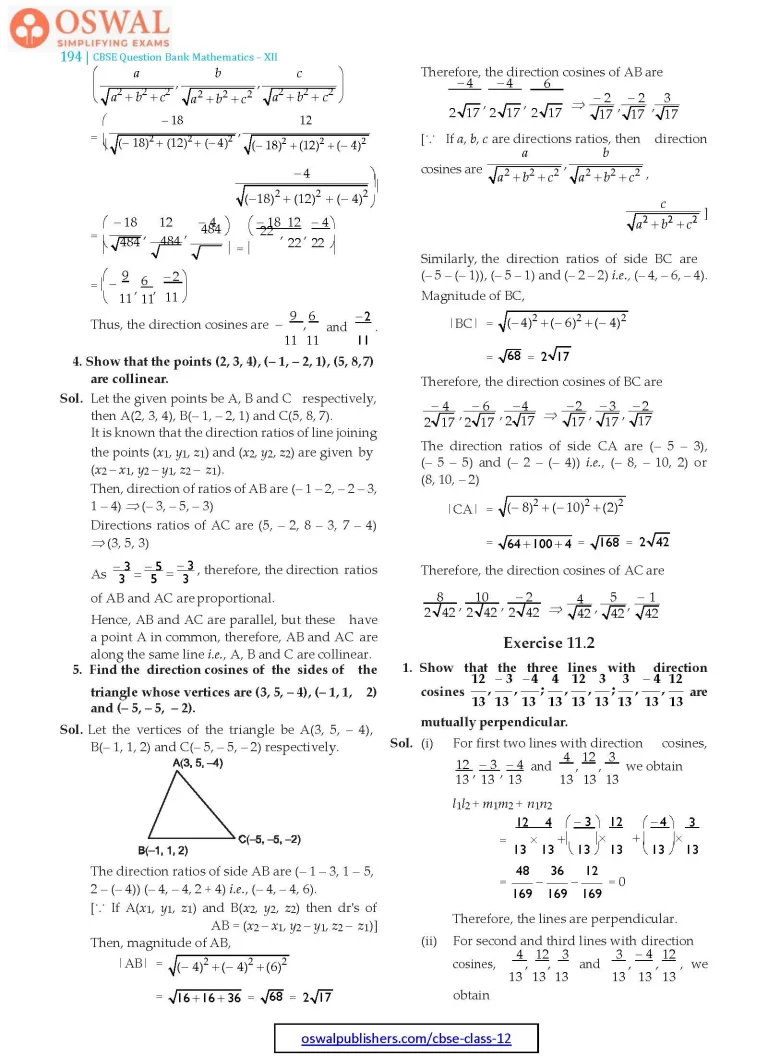
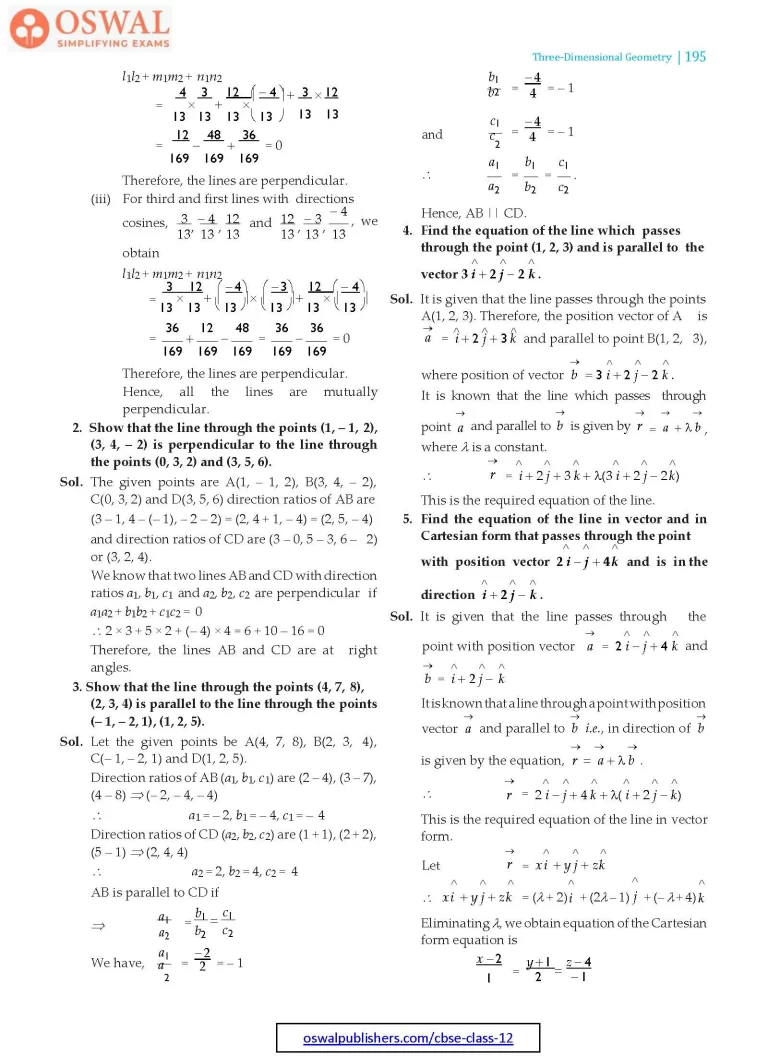

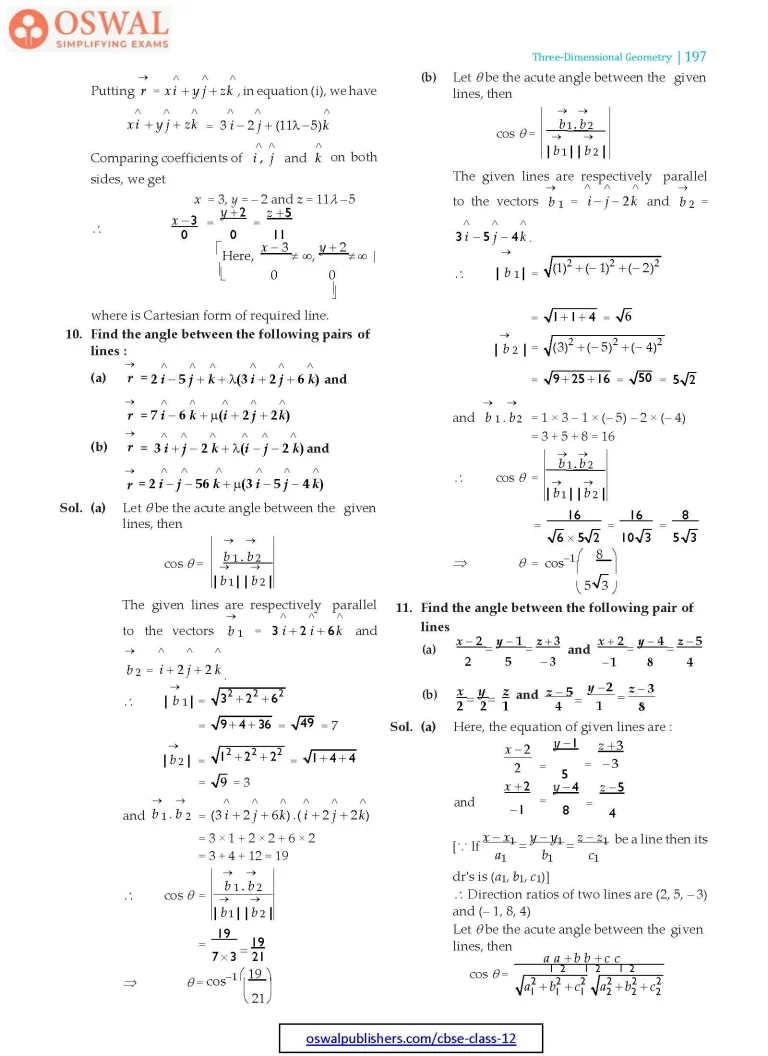

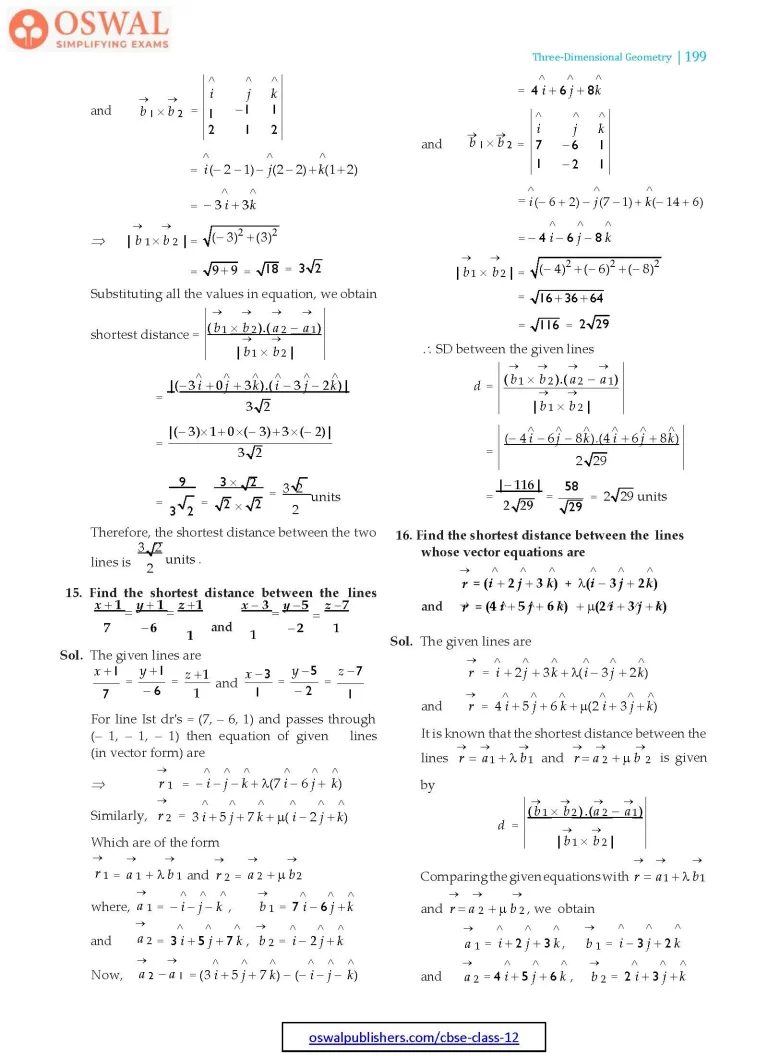
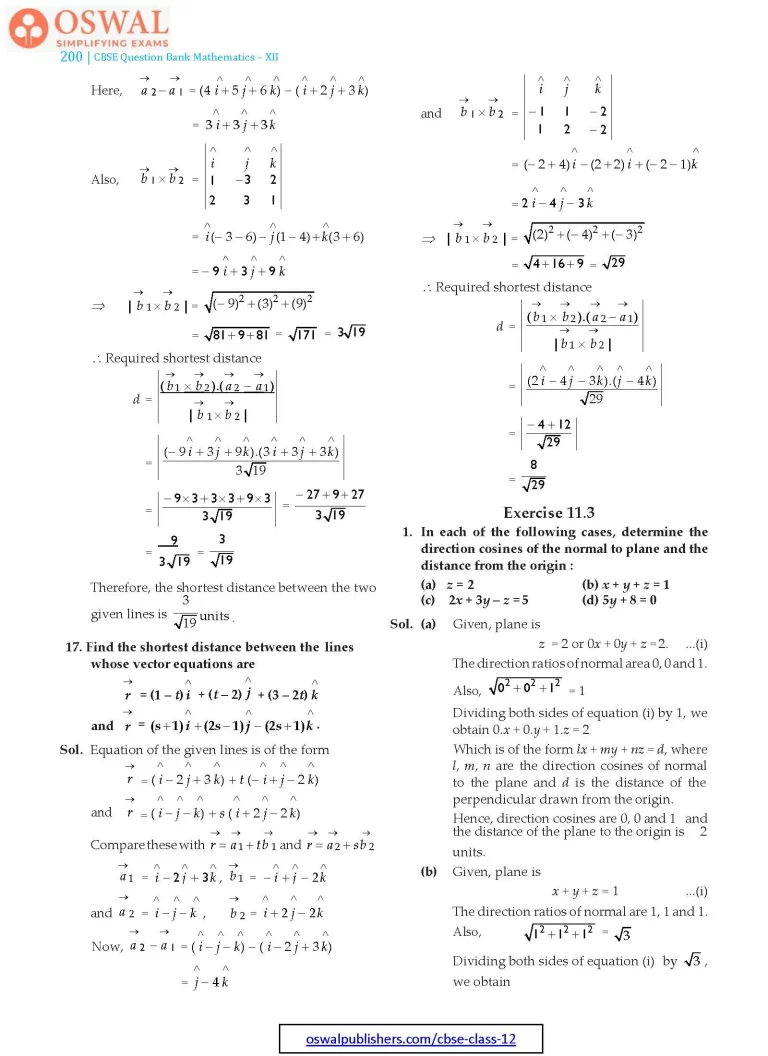
Access Exercises of Class 12 Maths Chapter 11 – Three Dimensional Geometry
Exercise 11.1 Solutions 5 Questions
Exercise 11.2 Solutions 17 Questions
Exercise 11.3 Solutions 14 Questions
Miscellaneous Exercise On Chapter 11 Solutions 23 Questions
Exercise 11.2
1. Show that the three lines with direction cosines
$$\frac{\textbf{12}}{\textbf{13}}\textbf{,}\frac{\textbf{-3}}{\textbf{13}}\textbf{,}\frac{\textbf{-4}}{\textbf{13}}\textbf{,}\frac{\textbf{4}}{\textbf{13}}\textbf{,}\frac{\textbf{12}}{\textbf{13}}\textbf{,}\frac{\textbf{3}}{\textbf{13}}\textbf{,}\frac{\textbf{-4}}{\textbf{13}}\textbf{,}\frac{\textbf{12}}{\textbf{13}}\\\textbf{are}\space\textbf{mutually perpendicular.}$$
Sol. (i) For first two lines with direction cosines,
$$\frac{12}{13},\frac{-3}{13},\frac{-4}{13}\space\text{and}\space\frac{4}{13},\frac{12}{13},\frac{3}{13}\\\text{we obtain}\\ l_1l_2 +m_1m_2+n_1n_2\\=\frac{12}{13}×\frac{4}{13} +\bigg(\frac{-3}{13}\bigg)×\frac{12}{13} + \bigg(\frac{-4}{13}\bigg)×\frac{3}{13}\\=\frac{48}{169} - \frac{36}{169} -\frac{12}{169} = 0$$
Therefore, the lines are perpendicular.
(ii) For second and third lines with direction cosines,
$$\frac{4}{13},\frac{12}{13},\frac{3}{13},\text{and}\space\frac{3}{13},\frac{-4}{13},\frac{12}{13},\\\text{we obtain}\\l_1l_2+m_1m_2+n_1n_2\\=\frac{4}{13}×\frac{3}{13}+\frac{12}{13}×\bigg(\frac{-4}{13}\bigg)+\frac{3}{13}×\frac{12}{13}\\=\frac{12}{169}-\frac{48}{169}+\frac{36}{169} = 0$$
Therefore, the lines are perpendicular.
(iii) For third and first lines with directions cosines,
$$\frac{3}{13},\frac{-4}{13},\frac{12}{13}\text{and}\space\frac{12}{13},\frac{-3}{13},\frac{-4}{13},\\\text{we obtain}\\l_1l_2 + m_1m_2+n_1n_2\\=\frac{3}{13}×\frac{12}{13} +\bigg(\frac{-4}{13}\bigg)×\bigg(\frac{-3}{13}\bigg)+\\\frac{12}{13}×\bigg(\frac{-4}{13}\bigg)\\=\frac{36}{169}+\frac{12}{169}-\frac{48}{169}\\=\frac{36}{169}-\frac{36}{169}=0$$
Therefore, the lines are perpendicular.
Hence, all the lines are mutually perpendicular.
2. Show that the line through the points (1, – 1, 2), (3, 4, – 2) is perpendicular to the line through the points (0, 3, 2) and (3, 5, 6).
Sol. The given points are A(1, – 1, 2), B(3, 4, – 2), C(0, 3, 2) and D(3, 5, 6) direction ratios of AB are (3 – 1, 4 – (– 1), – 2 – 2) = (2, 4 + 1, – 4) = (2, 5, – 4) and direction ratios of CD are (3 – 0, 5 – 3, 6 – 2) or (3, 2, 4).
We know that two lines AB and CD with direction ratios a1, b1, c1 and a2, b2, c2 are perpendicular if a1a2 + b1b2 + c1c2 = 0
∴ 2 × 3 + 5 × 2 + (– 4) × 4 = 6 + 10 – 16 = 0
Therefore, the lines AB and CD are at right angles.
3. Show that the line through the points (4, 7, 8), (2, 3, 4) is parallel to the line through the points (– 1, – 2, 1), (1, 2, 5).
Sol. Let the given points be A(4, 7, 8), B(2, 3, 4), C(– 1, – 2, 1) and D(1, 2, 5).
Direction ratios of AB (a1, b1, c1) are (2 – 4), (3 – 7), (4 – 8) ⇒ (– 2, – 4, – 4)
∴ a1 = – 2, b1 = – 4, c1 = – 4
Direction ratios of CD (a2, b2, c2) are (1 + 1), (2 + 2), (5 – 1) ⇒ (2, 4, 4)
∴ a2 = 2, b2 = 4, c2 = 4
AB is parallel to CD if
$$\Rarr\space \frac{a_1}{a_2}=\frac{b_1}{b_2}=\frac{c_1}{c_2}\\\text{we have,}\space\frac{a_1}{a_2} =\frac{-2}{2}=-1\\\frac{b_1}{b_2} =\frac{-4}{4}=-1\\\text{and}\space\frac{\text{c}_1}{\text{c}_2}=\frac{-4}{4}=-1\\\therefore\frac{a_1}{a_2} =\frac{b_1}{b_2}=\frac{c_1}{c_2}$$
Hence, AB || CD.
4. Find the equation of the line which passes through the point (1, 2, 3) and is parallel to the vector
$$\textbf{3}\hat{\textbf{i}}\textbf{+ 2}\hat{\textbf{j}}\textbf{-2}\hat{\textbf{k}}\textbf{.}$$
Sol. It is given that the line passes through the points A(1, 2, 3). Therefore, the position vector of A is
$$\vec{a} =\hat{i}+2\hat{j}+3\hat{k}\space\text{and parallel to point B(1, 2, 3),}\\\text{where position of vector}\space\vec{b} = 3\hat{i}+ 2\hat{j}-2\hat{k.}$$
It is known that the line which passes through point
$$\vec{a}\space\text{and parallel to}\space\vec{b}\space\text{is given by}\\\vec{r} =\vec{a} +\lambda\vec{b}\\\text{where}\space\lambda\space\text{is a constant.}\\\therefore\space \vec{r} = \hat{i} + 2\hat{j}+3\hat{k}+\lambda(3\hat{i} +2\hat{j}-2\hat{k})$$
This is the required equation of the line.
5. Find the equation of the line in vector and in Cartesian form that passes through the point with position vector $$\textbf{2}\hat{\textbf{i}}\textbf{-}\hat{\textbf{j}}\textbf{+ 4}\hat{\textbf{k}}\space\textbf{and is in the direction}\\\hat{\textbf{i}}\textbf{+}\textbf{2}\hat{\textbf{j}} -\hat{\textbf{k}}\textbf{.}$$
Sol. It is given that the line passes through the point with position vector
$$\vec{a} = 2\hat{i}-\hat{j}+4\hat{k}\space\text{and}\space \vec{\text{b}} =\hat{i}+ 2\hat{j}-\hat{k}$$
It is known that a line through a point with position vector
$$\vec{a}\space\text{and parallel to}\space\vec{b}\space\text{i.e., in direction of}\space\vec{b}\\\text{i.e., in direction of}\space\vec{r} = \vec{a} +\lambda\vec{b}.\\\therefore\space \vec{r} = 2\hat{i} -\hat{j}+4\hat{k}+\lambda(\hat{i}+ 2\hat{j}-\hat{k})$$
This is the required equation of the line in vector form.
$$\text{Let}\space \vec{r} = x\hat{i} + y\hat{j}+z\hat{k}\\\therefore\space x\hat{i}+y\hat{j}+z\hat{k}=\\(\lambda+2)\hat{i} + (2\lambda-1)\hat{j} + (-\lambda+4)\hat{k}$$
Eliminating λ, we obtain equation of the Cartesian form equation is
$$\frac{x-2}{1} =\frac{y+1}{2} =\frac{z-4}{-1} $$
This is the required equation of the given line in Cartesian form.
6. Find the Cartesian equation of the line which passes through the point (– 2, 4, – 5) and parallel to the line given by
$$\frac{\textbf{x + 3}}{\textbf{3}} =\frac{\textbf{y - 4}}{\textbf{5}} =\frac{\textbf{z + 8}}{\textbf{6}}\textbf{.}$$
Sol. It is given that the line passing through the point (– 2, 4, – 5) and is parallel to
$$\frac{x+3}{3}=\frac{y-4}{5}=\frac{z+8}{6}$$
The direction ratios of the line
$$\frac{x+3}{3}=\frac{y-4}{5}=\frac{z+8}{6}\\\text{are (3, 5, 6)}$$
The required line is parallel to
$$\frac{x+3}{3} =\frac{y-4}{5} =\frac{z+8}{6}.$$
It is known that the equation of the line passing through the point (x1, y1, z1) and with direction ratios a, b, c is given by
$$\frac{x-x_1}{a} =\frac{y-y_1}{b} =\frac{z-z_1}{c}.$$
Also, the line passes through (– 2, 4, – 5) and having direction ratios (3, 5, 6) therefore, the equation of the line (in Cartesian form) is
$$\frac{x-(-2)}{3} = \frac{y-4}{5}\\=\frac{z-(-5)}{6}. $$
$$\Rarr\space \frac{x+2}{3}=\space \frac{y-4}{5}=\space \frac{z+5}{6}$$
which is the equation of required line.
7. The Cartesian equation of a line is
$$\frac{\textbf{x-5}}{\textbf{3}} =\frac{\textbf{y+4}}{\textbf{7}} =\frac{\textbf{z-6}}{\textbf{2}},\\\textbf{write its vector form.}$$
Sol. The given Cartesian equation of a line is
$$\frac{x-5}{3}=\frac{y+4}{7}=\frac{z-6}{1}$$
The above line passes through the point (5, – 4, 6). The position vector of this point is
$$\vec{a} = 5\hat{i} -4\hat{j} + 6\hat{k}.$$
Also, the direction ratios of the given line are 3, 7 and 2. This means that the line is in the direction of vector,
It is known that the line through position vector
$$\vec{b} = 3\hat{i} + 7\hat{j}+6\hat{k}.$$
$$\vec{a}\space\text{and in the direction of the vector}\space\vec{\text{b}}\\\text{is given by the equation,}\\\vec{r} =\vec{a} + \lambda\vec{b},\space\lambda\epsilon R\\\therefore\space \vec{r} = 5\hat{i}-4\hat{j}+6\hat{k} + \lambda(3\hat{i} + 7\hat{j}+2\hat{k})$$
This is the required equation of the given line in vector form.
8. Find the vector and the Cartesian equations of the line that passes through the origin and (5, – 2, 3).
$$\textbf{Sol.}\space\text{Let}\space\vec{a}\space\text{and}\space\vec{b}\space\text{be the position vectors}\\\text{of points (0, 0, 0) and (5, – 2, 3) respectively.}\\\therefore\space \vec{a}= 0\hat{i} +0\hat{j}+0\hat{k} \text{and}\space \vec{b} = 5\hat{i} - 2\hat{j}+3\hat{k}$$
We know that the vector equation of a line passing through the points having position vector
$$\vec{a}\space\text{and}\space\vec{b}\space\text{is}\space\vec{r} = \vec{a} + \lambda(\vec{b}-\vec{a})\\\therefore\space \vec{r} =0\lambda(5\hat{i} - 2\hat{j}+3\hat{k}-0)\\\Rarr\space \vec{r} =\lambda(5\hat{i}-2\hat{j}+3\hat{k})\space\text{...(i)}$$
(which is vector equation)
$$\text{Putting\space}\vec{r} = x\hat{i}+y\hat{j}+z\hat{k}\\\text{in equation (i), we have}\\x\hat{i}+y\hat{j}+z\hat{k} =\lambda(5\hat{i}-2\hat{j}+3\hat{k})\\\Rarr\space x\hat{i}+y\hat{j}+z\hat{k}\\=5\lambda\hat{i}-2\lambda\hat{j}+3\lambda\hat{k}$$
$$\text{Comparing coefficient of}\space\hat{i},\hat{j}\space\text{and}\space\hat{k}\\\text{on both sides, we have}\\x =5\lambda, y=-2\lambda\text{and} z=3\lambda\\\therefore\space\frac{x}{5}=\frac{y}{-2} =\frac{z}{3}=1$$
which is Cartesian form of required line.
9. Find the vector and the Cartesian equation of the line that passes through the points (3, – 2, – 5), (3, – 2, 6).
$$\textbf{Sol.\space}\text{Let}\space \vec{a}\text{and}\vec{b}\space\text{be the position vectors of}\\\text{points (3, – 2, – 5) and (3, – 2, 6) respectively.}\\\therefore\space\vec{a} = 3\hat{i}-2\hat{j}-5\hat{k}\space\text{and}\space \vec{b} = 3\hat{i}-2\hat{j}+6\hat{k}$$
We know that the vector equation of a line passing through the points having position
$$\text{vectors}\space\vec{a}\space\text{and}\space\vec{b}\space\text{is}\space\vec{r} = \vec{a} + \lambda(\vec{b}-\vec{a}).\\\therefore\space \vec{r} = 3\hat{i}-2\hat{j}-5\hat{k}+\lambda\lbrack(3\hat{i}-2\hat{j}+6\hat{k})-\\(3\hat{i}-2\hat{j}-5\hat{k})\rbrack\\\Rarr\space\vec{r} = 3\hat{i}-2\hat{j}-5\hat{k} + \lambda\lbrack 3\hat{i}-2\hat{j}+6\hat{k}-\\ 3\hat{i}+2\hat{j}+5\hat{k}\rbrack\\\Rarr\space\vec{r} = 3\hat{i}-2\hat{j}-5\hat{k}+\lambda(11 \hat{k})\space\text{...(i)}\\\text{(which is vector equation)}\\\text{Putting}\space\vec{r} = x\hat{i}+y\hat{j}+z\hat{k},\space\text{in equation (i),}\\\text{we have}\\ x\hat{i}+y\hat{j}+z\hat{k} = 3\hat{i}-2\hat{j}+(11\lambda - 5)\hat{k}\\\text{Comparing coefficients of}\space\hat{i},\hat{j}\text{and}\hat{k}\\\text{om both sides, we get}$$
x = 3, y = – 2 and z = 11λ – 5
$$\therefore\space \frac{x-3}{0}=\frac{y+2}{0}=\frac{z+5}{11}\\\bigg[\text{Here,}\frac{x-3}{0}\neq \infty,\frac{y+2}{0}\neq\infty\bigg]$$
where is Cartesian form of required line.
10. Find the angle between the following pairs of lines :
$$\textbf{(a)\space}\vec{\textbf{r}} \textbf{=} 2\hat{\textbf{i}}\textbf{-5}\hat{\textbf{j}} \textbf{+}\hat{\textbf{k}} \textbf{+}\lambda \textbf{(3}\hat{\textbf{i}} \textbf{+ 2}\hat{\textbf{j}} \textbf{+ 6}\hat{\textbf{k}}\textbf{)}\\\textbf{and}\space\vec{\textbf{r}} \textbf{= 7}\hat{\textbf{i}} \textbf{- 6}\hat{\textbf{k}} +\mu(\hat{\textbf{i}} \textbf{+ 2}\hat{\textbf{j}} \textbf{+} 2\hat{\textbf{k}})\\\textbf{(b)\space}\vec{\textbf{r}} \textbf{ = 3}\hat{\textbf{i}} \textbf{+}\hat{\textbf{j}}\textbf{- 2}\hat{\textbf{k}} +\lambda(\hat{\textbf{i}} \textbf{-}\hat{\textbf{j}}\textbf{-2}\hat{\textbf{k}}\textbf{)}\space\textbf{and}\\\vec{\textbf{r}} \textbf{=} \textbf{2}\hat{\textbf{i}} \textbf{- j}\textbf{- 56}\hat{\textbf{k}} \textbf{+} \mu \textbf{(3}\hat{\textbf{i}}\textbf{-5}\hat{\textbf{j}}\textbf{-4}\hat{\textbf{k}}\textbf{)}\\\textbf{Sol.\space(a)}\space\text{Let}\space\theta\space\text{be the acute angle}\\\text{between the given lines, then}\\\text{cos}\space\theta = \begin{vmatrix}\frac{\vec{b}_1.\vec{b}_2}{|\vec{b_1}||\vec{b_2}|}\end{vmatrix}$$
The given lines are respectively parallel to the vectors
$$\vec{b}_1 = 3\hat{i}+2\hat{i}+6\hat{k}\space\text{and}\space\vec{b}_2 = \hat{i} + 2\hat{j}+2\hat{k}\\\therefore\space |\vec{b}_1| =\sqrt{3^{2}+2^{2}+6^{2}}\\=\sqrt{9+4+36} =\sqrt{49}=7\\|\vec{b}_2| = \sqrt{1^{2}+2^{2}+2^{2}} =\sqrt{1+4+4}\\=\sqrt{9} = 3\\\text{and}\space \vec{b}_1.\vec{b}_2 = (3\hat{i} + 2\hat{j}+6\hat{k}).(\hat{i}+2\hat{j}+2\hat{k})$$
= 3 × 1 + 2 × 2 + 6 × 2
= 3 + 4 + 12 = 19
$$\therefore\space \text{cos}\space\theta =\begin{vmatrix}\frac{\vec{b}_1.\vec{b}_2}{|\vec{b}_1|\vec{b}_2|}\end{vmatrix}\\=\frac{19}{7×3}=\frac{19}{21}\\\Rarr\space\theta = \text{cos}^{\normalsize-1}\bigg(\frac{19}{21}\bigg)$$
(b) Let θ be the acute angle between the given lines, then
$$\text{cos}\space\theta =\begin{vmatrix}\frac{\vec{b_1}\vec{b_2}}{|\vec{b}_1||\vec{b}_2|}\end{vmatrix}$$
The given lines are respectively parallel to the vectors
$$\vec{b}_1 =\hat{i} - \hat{j}+2\hat{k}\text{and}\space \vec{b_2} = 3\hat{i}-5\hat{j}-4\hat{k}.\\\therefore\space |\vec{b_1}| = \sqrt{(1)^{2}+(\normalsize-1)^{2}+ (\normalsize-2)^{2}}\\=\sqrt{1+1+4} = \sqrt{6}\\|\vec{b}_2| = \sqrt{(3)^{2}+(-5)^{2}+(-4)^{2}}\\=\sqrt{9 + 25 + 16} =\sqrt{50} =5\sqrt{2}\\\text{and}\space\vec{b}_1.\vec{b}_2 = 1×3-1×(-5)-2×(-4)$$
= 3 + 5 + 8 = 16
$$\therefore\space\text{cos}\space\theta = \begin{vmatrix}\frac{\vec{b_1}.\vec{b_2}}{|\vec{b}_1||\vec{b}_2|}\end{vmatrix}\\=\frac{16}{\sqrt{6}×5\sqrt{2}} =\frac{16}{10\sqrt{3}} =\frac{8}{5\sqrt{3}}\\\Rarr\space\theta = \text{cos}^{\normalsize-1}\bigg(\frac{8}{5\sqrt{3}}\bigg)$$
11. Find the angle between the following pair of lines
$$\textbf{(a)\space}\frac{\textbf{x-2}}{\textbf{2}} =\frac{\textbf{y-1}}{\textbf{5}}=\frac{\textbf{z+3}}{\textbf{\normalsize-3}}\space\textbf{and}\\\frac{\textbf{x+2}}{\textbf{\normalsize-1}} \textbf{=}\frac{\textbf{y-4}}{\textbf{8}} \textbf{=}\frac{\textbf{z-5}}{\textbf{4}}\\\textbf{(b)\space}\frac{\textbf{x}}{\textbf{2}} \textbf{=} \frac{\textbf{y}}{\textbf{2}} \textbf{=}\frac{\textbf{z}}{\textbf{1}}\textbf{and}\space\frac{\textbf{z-5}}{\textbf{4}} =\frac{\textbf{y-2}}{\textbf{1}} =\frac{\textbf{z-3}}{\textbf{8}}$$
Sol. (a) Here, the equation of given lines are :
$$\frac{x-2}{2} = \frac{y-1}{5} = \frac{z+3}{-3}\\\text{and}\space\frac{x+2}{\normalsize-1} =\frac{\text{y-4}}{8} = \frac{z-5}{4}\\\lbrack\because\space\text{If}\space\frac{x-x_1}{a_1} =\frac{y-y_1}{b_1} =\frac{z-z_1}{c_1}\\\text{be a line then its dr's is (}a_1, b_1, c_1)\rbrack$$
∴ Direction ratios of two lines are (2, 5, – 3) and (– 1, 8, 4)
Let θ be the acute angle between the given lines, then
$$\text{cos}\space\theta = \frac{a_1a_2 + b_1b_2 + c_1c_2}{\sqrt{a_1^{2}+b_1^{2} + c_1^{2}}\sqrt{a_{2}^{2} + b_{2}^{2}+c_{2}^{2}}}$$
$$\Rarr\space\text{cos}\space\theta =\frac{2×(\normalsize-1)+5×8+(\normalsize-3)×4}{\sqrt{2^{2}+5^{2}+(-3)^{2}}\sqrt{(-1)^{2}+8^{2}+4^{2}}}$$
$$= \frac{-2 + 40-12}{\sqrt{4 +25 + 9}\sqrt{1 + 64 +16}}\\=\frac{26}{\sqrt{38}\sqrt{81}}\\=\frac{26}{9\sqrt{38}}\\\Rarr\space \theta =\text{cos}^{\normalsize-1}\bigg(\frac{26}{9\sqrt{38}}\bigg)$$
(b) Here, the equation of given lines are
$$\frac{x}{2} = \frac{y}{2} = \frac{z}{1} \text{and}\space\\\frac{x-5}{4}=\frac{y-2}{1} =\frac{z-3}{8}$$
∴ Directions ratios of two lines are (2, 2, 1) and (4, 1, 8).
Let θ be the acute angle between the given lines, then
$$\text{cos}\space\theta =\frac{a_1a_2 +b_1b_2 +c_1c_2}{\sqrt{a_1^{2}+b_1^{2}+c_1^{2}}\sqrt{a_2^{2}+b_2^{2}+c_2^{2}}}\\\Rarr\space \text{cos}\space\theta = \frac{2×4 +2×1+1×8}{\sqrt{2^{2}+2^{2}+1^{1}}\sqrt{4^{2}+1^{2}+8^{2}}}\\=\frac{8+2+8}{\sqrt{4+4+1}\sqrt{16+1+64}}\\=\frac{18}{\sqrt{9}\sqrt{81}} =\frac{18}{3×9}=\frac{2}{3}\\\therefore\space\theta = \text{cos}^{\normalsize-1}\bigg(\frac{2}{3}\bigg)$$
12. Find the values of p so that the lines
$$\frac{\textbf{1-x}}{\textbf{3}} \textbf{=} \frac{\textbf{7y-14}}{\textbf{2p}} \textbf{=}\frac{\textbf{z-3}}{\textbf{2}}\\\textbf{and}\space\frac{\textbf{7-7x}}{\textbf{3p}}\textbf{=}\frac{\textbf{y-5}}{\textbf{1}} \textbf{=}\frac{\textbf{6-z}}{\textbf{5}}\\\textbf{are at right angles.}$$
Sol. Equation of the given lines can be written in standard form as
$$\frac{x-1}{-3} = \frac{y-2}{\frac{2p}{7}} =\frac{z-3}{2}\\\text{and}\space \frac{x-1}{-\frac{3p}{7}} = \frac{y-5}{1}=\frac{z-6}{-5}$$
Direction ratios of these lines are respectively
$$-3,\frac{2p}{7},2\space\text{and}\space\frac{-3p}{7},1,-5.$$
Two lines with direction ratios a1, b1, c1 and a2, b2, c2 are perpendicular to each other, if a1a2 + b1b2 + c1c2 = 0.
$$\therefore\space (-3)\bigg(\frac{-3p}{7}\bigg) + \bigg(\frac{2p}{7}\bigg)(1) + (2)(\normalsize-5) =0$$
$$\Rarr\space\frac{9p}{7} + \frac{2p}{7}-10 =0\\\Rarr\space\frac{11p}{7} =10\\\Rarr\space p = \frac{70}{11}\\\text{Thus, the value of p =}\frac{70}{11}$$
Note : For making a line in standard form, ensure that coefficient of variable should be non-negative and constant.
$$\textbf{13. Show that the lines}\space\frac{\textbf{x-5}}{\textbf{7}} =\frac{\textbf{y+2}}{\textbf{\normalsize-5}} = \frac{\textbf{z}}{\textbf{1}}\\\textbf{and}\space\frac{\textbf{x}}{\textbf{1}} \textbf{=}\frac{\textbf{y}}{\textbf{2}} \textbf{=}\frac{\textbf{x}}{\textbf{3}}\space\textbf{are perpendicular}\\\textbf{to each other.}$$
Sol. The equations of the given lines are :
$$\frac{\text{x-5}}{\text{7}} \text{=}\frac{\text{y+2}}{\text{\normalsize-5}} \text{=}\frac{\text{z}}{\text{1}}\text{and}\space\frac{\text{x}}{\text{1}}\text{=}\frac{\text{y}}{\text{2}} \text{=}\frac{\text{z}}{\text{3}}\text{.}$$
Direction ratios of the given lines are respectively 7, – 5, 1 and 1, 2, 3.
Two lines with direction ratios a1, b1, c1 and a2, b2, c2 are perpendicular to each other, if
a1a2 + b1b2 + c1c2 = 0
∴ (7)(1) + (– 5)(2) + (1)(3) = 7 – 10 + 3 = 0
Therefore, the given lines are perpendicular.
14. Find the shortest distance between the lines
$$\vec{\textbf{r}} \textbf{=}\space (\hat{\textbf{i}} \textbf{+ 2}\hat{\textbf{j}} \textbf{+}\hat{\textbf{k}})\textbf{ +} \lambda(\hat{\textbf{i}} \textbf{-} \hat{\textbf{j}} \textbf{+} \hat{\textbf{k}})\space\textbf{and}\\\vec{\textbf{r}} \textbf{=(} \textbf{2}\hat{\textbf{i}} \textbf{-}\hat{\textbf{j}}\textbf{-}\hat{\textbf{k}}) \textbf{+} \mu\textbf{(2}\hat{\textbf{i}}\textbf{+}\hat{\textbf{j}} \textbf{+ 2}\hat{\textbf{k}}\textbf{).} $$
Sol. The given equations are
$$\vec{r} = \hat{i}+2\hat{j}+\hat{k} + \lambda(\hat{i}-\hat{j}+\hat{k})\\\text{and}\space \vec{r} = (2\hat{i} +\hat{j}+\hat{k})+ \mu(2\hat{i} + \hat{j}+2\hat{k})\\\text{which is of the form}\space\vec{r} = \vec{a}_1 + \lambda\vec{b}_1\\\text{and}\space \vec{r} = \vec{a}_2 + \lambda\vec{b_2}\\\vec{a}_1 =\hat{i} + 2\hat{j}+\hat{k},\vec{b}_1 =\hat{i} -\hat{j}+\hat{k}\\\text{and}\space\vec{a}_2 =2\hat{i}-\hat{j}-\hat{k},\vec{b}_2 = 2\hat{i} +\hat{j}+2\hat{k}\\\text{Now,\space}\vec{a}_2-\vec{a}_1 = (2\hat{i}-\hat{j}-\hat{k})-\\(\hat{i}+2\hat{j}+\hat{k})\\=\hat{i} -3\hat{j}-2\hat{k}\\\text{and}\space\vec{b_1}×\vec{b_2} = \begin{vmatrix}\hat{i}&\hat{j}&\hat{k}\\1 &-1&1\\2 &1 &2\end{vmatrix}\\ =\hat{i}(-2-1) -\hat{j}(2-2) + \hat{k}(1+2)$$
$$ =- 3\hat{i} + 3 \hat{k}\\\Rarr\space |\vec{b}_1×\vec{b}_2| = \sqrt{(-3)^{2}+(3)^{2}}\\=\sqrt{9+9}=\sqrt{18}= 3\sqrt{2}$$
Substituting all the values in equation, we obtain
$$\text{shortest distance =}\begin{vmatrix}\frac{(\vec{b}_1×\vec{b}_2).(\vec{a_2} -\vec{a}_1)}{|\vec{b}_1×\vec{b}_2|}\end{vmatrix}\\=\frac{|(-3\hat{i} + 0\hat{j} + 3\hat{k}).(\hat{i}-3 \hat{j}-2\hat{k})|}{3\sqrt{2}}\\=\frac{|(-3)×1 + 0×(\normalsize-3)+3×(\normalsize-2)|}{3\sqrt{2}}\\=\frac{9}{3\sqrt{2}} =\frac{3×\sqrt{2}}{\sqrt{2}×\sqrt{2}} =\frac{3\sqrt{2}}{2}\text{units}$$
Therefore, the shortest distance between the two lines is
$$\frac{3\sqrt{2}}{2}\text{units.}$$
15. Find the shortest distance between the lines
$$\frac{\textbf{x+1}}{\textbf{7}} \textbf{=}\frac{\textbf{y+1}}{\textbf{-6}} =\frac{\textbf{z+1}}{1}\textbf{and}\\\frac{\textbf{x-3}}{\textbf{1}} \textbf{=}\frac{\textbf{y-5}}{\textbf{-2}} \textbf{=}\frac{\textbf{z-7}}{\textbf{1}}$$
Sol. The given lines are
$$\frac{x+1}{7}=\frac{y+1}{-6}=\frac{Z+1}{1}\space\\\text{and}\space\frac{x-3}{1}=\frac{y-5}{-2}=\frac{z-7}{1}$$
For line Ist dr's = (7, – 6, 1) and passes through (– 1, – 1, – 1) then equation of given lines (in vector form) are
$$\Rarr\space \vec{r}_1 =-\hat{i}-\hat{j}-\hat{k}+\lambda(7\hat{i} -6\hat{j}+\hat{k})\\\text{Similarly,}\space\vec{r}_2 = 3\hat{i} + 5\hat{j} + 7\hat{k} + \\\mu(\hat{i} - 2\hat{j}+\hat{k}) $$
Which are of the form
$$\vec{r}_1 =\vec{a}_1+\lambda\vec{b}_1\space\text{and}\space\vec{r}_2 = \vec{a}_2 + \mu\vec{b}_2\\\text{where\space}\vec{a}_1 = -\hat{i}-\hat{j}-\hat{k},\\\vec{b}_1 = 7\hat{i}-6\hat{j}+\hat{k}\\\text{and}\space \vec{a}_2 = 3\hat{i} +5\hat{j}+7\hat{k},\vec{b}_2 = \hat{i} -2\hat{j}+\hat{k}\\\text{Now,\space}\vec{a}_2-\vec{a}_1 = (3\hat{i} + 5\hat{j}+7\hat{k})-\\(\normalsize-\hat{i}-\hat{j}-\hat{k})\\ = 4\hat{i} + 6\hat{j}+8\hat{k}\\\text{and}\space \vec{b_1}× \vec{b_2} =\begin{vmatrix}\hat{i} &\hat{j} &\hat{k}\\ 7 &-6 &1\\ 1&-2&1\end{vmatrix}$$
$$=\hat{i}(-6+2)-\hat{j}(7-1) +\hat{k}(-14+6)\\=-4\hat{i}-6\hat{j}-8\hat{k}$$
$$|\vec{b}_1×\vec{b}_2| = \sqrt{(-4)^{2} + (-6)^{2} + (-8)^{2}}\\=\sqrt{16+36+64}\\=\sqrt{116} =2\sqrt{29} $$
∴ SD between the given lines
$$d =\begin{vmatrix}\frac{(\vec{b}_1 ×\vec{b}_2).(\vec{a}_2-\vec{a}_1)}{|\vec{b_1}×\vec{b_2}|}\end{vmatrix}\\= \begin{vmatrix}\frac{(-4\hat{i}-6\hat{j}-8\hat{k}).(4\hat{i}+ 6\hat{j}+8\hat{k})}{2\sqrt{29}}\end{vmatrix}\\=\frac{|-116|}{2\sqrt{29}}=\frac{58}{\sqrt{29}}=2\sqrt{29}\space\text{units}$$
16. Find the shortest distance between the lines whose vector equations are
$$\vec{\textbf{r}} \textbf{=} \textbf{(}\hat{\textbf{i}} \textbf{+ 2}\hat{\textbf{j}}\textbf{+ 3}\hat{\textbf{k}}\textbf{)} \textbf{+} \lambda \textbf{(}\hat{\textbf{i}}\textbf{- 3}\hat{\textbf{j}}\textbf{+ 2}\hat{\textbf{k}}\textbf{)}\\\textbf{and\space}\vec{\textbf{r}} \textbf{= (} \textbf{4}\hat{\textbf{i}} \textbf{+ 5}\textbf{j} \textbf{+ 6}\hat{\textbf{k}}) \textbf{+}\mu\textbf{(2}\hat{\textbf{i}} \textbf{+ 3}\hat{\textbf{j}} \textbf{+} \hat{\textbf{k}})$$
Sol. The given lines are
$$\vec{r} =\hat{i}+2\hat{j}+3\hat{k} + \lambda(\hat{i}-3\hat{j}+2\hat{k})\\\text{and}\space\vec{r} = (4\hat{i} + 5\hat{j}+6\hat{k}) + \mu(2\hat{i} + 3\hat{j}+\hat{k})$$
It is known that the shortest distance between the lines
$$\vec{r} =\vec{a}_1 + \lambda\vec{b}_1\space\text{and}\space \vec{r} = \vec{a}_2 + \mu \vec{b}_2\\\text{is given by}\\\text{d}= \begin{vmatrix}\frac{(\vec{b}_1×\vec{b}_2).(\vec{a}_2-\vec{a}_1)}{|\vec{b}_1×\vec{b}_2|}\end{vmatrix}\\\text{Comparing the given equations with}\\\vec{r} = \vec{a}_1 + \lambda\vec{b}_1\space\text{and}\space\vec{r}= \vec{a}_2 +\mu\vec{b}_2,\\\text{we obtain}\\\vec{a}_1 = \hat{i} + 2\hat{j} +3\hat{k},\space\vec{b}_1 = \hat{i} -3\hat{j}+2\hat{k}\\\text{and}\space \vec{a}_2 = 4\hat{i} + 5\hat{j}+6\hat{k},\space \vec{b}_2 = 2\hat{i} + 3\hat{j}+\hat{k}$$
$$\text{Here},\space\vec{a}_2-\vec{a}_1 =(4\hat{i} + 5\hat{j}+6\hat{k})-\\(\hat{i} + 2\hat{j}+3\hat{k})\\=3\hat{i}+3\hat{j}+3\hat{k}\\\text{Also,\space}\vec{b_1}×\vec{b_2} =\begin{vmatrix}\hat{i} &\hat{j}&\hat{k}\\ 1 &-3 &2\\ 2&-3 &1\end{vmatrix}\\=\hat{i}(-3-6)-\hat{j}(1-4)+\\\hat{k}(3+6)\\=-9\hat{i}+3\hat{j}+9\hat{k}\\\Rarr\space |\vec{b}_1×\vec{b}_2| =\\\sqrt{(-9)^{2}+(3)^{2}+(9)^{2}}\\=\sqrt{81+ 9+81} =\sqrt{171}\\=3\sqrt{19}$$
∴ Required shortest distance
$$ d = \begin{vmatrix}\frac{(\vec{b}_1×\vec{b}_2).(\vec{a}_2-\vec{a}_1)}{|\vec{b}_1×\vec{b}_2|}\end{vmatrix}\\=\begin{vmatrix}\frac{(-9\hat{i}+3\hat{j}+9\hat{k}).(3\hat{i}+3\hat{j}+3\hat{k})}{3\sqrt{19}}\end{vmatrix}\\=\bigg|\frac{-9×3+3×3+9×3}{3\sqrt{19}}\bigg|\\= \frac{-27 +9+27} {3\sqrt{19}}\\=\frac{9}{3\sqrt{19}} = \frac{3}{\sqrt{19}}$$
Therefore, the shortest distance between
the two given lines is
$$\frac{3}{\sqrt{19}}\space\text{units.}$$
17. Find the shortest distance between the lines whose vector equations are
$$\vec{\textbf{r}} \textbf{= (1-t)}\hat{\textbf{i}} \textbf{+}\textbf{(t-2)}\hat{\textbf{j}} \textbf{+}\textbf{(3-2t)}\hat{\textbf{k}}\\\textbf{and}\space\vec{\textbf{r}} \textbf{=}\textbf{(s+1)}\hat{\textbf{i}} \textbf{+ (2s-1)}\hat{\textbf{j}}\textbf{-}\\\textbf{(2s+1)}\hat{\textbf{k}}\textbf{.} $$
Sol. Equation of the given lines is of the form
$$\vec{r} = (\hat{i} - 2\hat{j}+3\hat{k}) + t(\hat{i} +\hat{j}-2\hat{k})\\\text{and}\space \vec{r} = (\hat{i} -\hat{j}-\hat{k}) + s(\hat{i} +2\hat{j}-2\hat{k})\\\text{Compare these with}\\\vec{r} = \vec{a}_1 + \vec{b}_1 \text{and}\space \vec{r} = \vec{a}_2 +s\vec{b}_2\\\vec{a}_1 = \hat{i}-2\hat{j} + 3\hat{k},\space \vec{b}_1 =-\hat{i} + \hat{j}-2\hat{k}\\\text{and}\space \vec{a}_2 =\hat{i} - \hat{j}-\hat{k},\\\vec{b}_2 = \hat{i} +2\hat{j}-2\hat{k}\\\text{Now,}\\\space\vec{a}_2-\vec{a}_1 =(\hat{i} -\hat{j}+\hat{k}) - (\hat{i} -2\hat{j}+3\hat{k})\\=\hat{j} - 4\hat{k}$$
$$\text{and}\space \vec{b}_1×\vec{b}_2 =\begin{vmatrix}\hat{i} &\hat{j}&\hat{k}\\-1 &2 &-2\\ 1 &2 &-2 \end{vmatrix}\\=(-2+4)\hat{i}-(2+2)\hat{j} + (-2-1)\hat{k}\\=2\hat{i}-4\hat{j}-3\hat{k}\\\Rarr\space |\vec{b}_1×\vec{b}_2| = \\\sqrt{(2)^{2}+(-4)^{2}+(-3)^{2}}\\=\sqrt{4+16+9}=\sqrt{29}$$
∴ Required shortest distance
$$d = \begin{vmatrix}\frac{(\vec{b}_1×\vec{b}_2).(\vec{a}_2-\vec{a}_1)}{|\vec{b}_1×\vec{b}_2|}\end{vmatrix}\\=\begin{vmatrix}\frac{(2\hat{i} -4\hat{j}-3\hat{k}).(\hat{j}-4\hat{k})}{\sqrt{29}}\end{vmatrix}\\=\frac{-4+12}{\sqrt{29}}\\=\frac{8}{\sqrt{29}}$$
Share page on
NCERT Solutions Class 12 Mathematics
- Chapter 1 Relations and Functions
- Chapter 2 Inverse Trigonometric Functions
- Chapter 3 Matrices
- Chapter 4 Determinants
- Chapter 5 Continuity and Differentiability
- Chapter 6 Application of Derivatives
- Chapter 7 Integrals
- Chapter 8 Applications of the Integrals
- Chapter 9 Differential Equations
- Chapter 10 Vectors
- Chapter 11 Three-Dimensional Geometry
- Chapter 12 Linear Programming
- Chapter 13 Probability
CBSE CLASS 12 NCERT SOLUTIONS
- NCERT Solutions Class 12 English Core
- NCERT Solutions Class 12 Physics
- NCERT Solutions Class 12 Chemistry
- NCERT Solutions Class 12 Biology
- NCERT Solutions Class 12 Business Studies
- NCERT Solutions Class 12 Mathematics
- NCERT Solutions Class 12 Accountancy
- NCERT Solutions Class 12 Economics
- NCERT Solutions Class 12 Geography
- NCERT Solutions Class 12 History
- NCERT Solutions Class 12 Political Science
CBSE CLASS 12 SYLLABUS
- CBSE Class 12 English core Syllabus
- CBSE Class 12 Mathematics Syllabus
- CBSE Class 12 Physics Syllabus
- CBSE Class 12 Chemistry Syllabus
- CBSE Class 12 Biology Syllabus
- CBSE Class 12 Accountancy Syllabus
- CBSE Class 12 Business Studies Syllabus
- CBSE Class 12 Economics Syllabus
- CBSE Class 12 History Syllabus
- CBSE Class 12 Geography Syllabus
- CBSE Class 12 Political science Syllabus
- CBSE Class 12 Sociology Syllabus
- CBSE Class 12 Psychology Syllabus
- CBSE Class 12 Physical education Syllabus
- CBSE Class 12 Applied mathematics Syllabus
- CBSE Class 12 History of Indian Arts Syllabus
CBSE CLASS 12 Notes
- CBSE Class 12 Physics Notes
- CBSE Class 12 Chemistry Notes
- CBSE Class 12 Biology Notes
- CBSE Class 12 Maths Notes
- CBSE Class 12 Accountancy Notes
- CBSE Class 12 Business Studies Notes
- CBSE Class 12 Economics Notes
- CBSE Class 12 History Notes
- CBSE Class 12 Geography Notes
- CBSE Class 12 Political Science Notes

